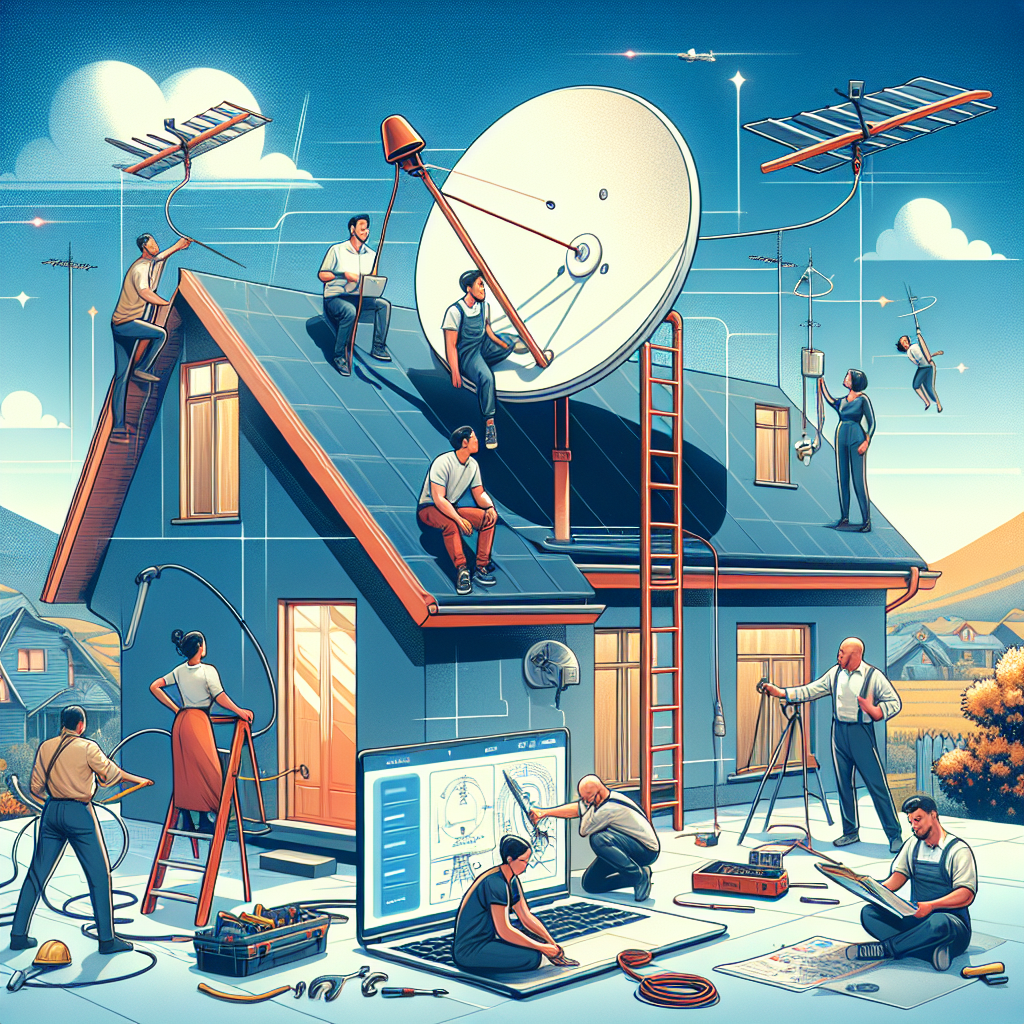Are you a DIY enthusiast looking to take your home entertainment setup to the next level? Look no further than the world of Satellite TV! This comprehensive guide will cover everything you need to know about exploring Satellite TV for DIY fans. From installing your own satellite dish to troubleshooting any signal issues, we’ve got you covered. Discover how to enhance your viewing experience with access to a wide range of channels and programming options. Whether you’re a seasoned DIYer or just getting started, Satellite TV offers endless possibilities for customizing your at-home entertainment setup.
Understanding Satellite TV for DIY Fans

Satellite TV is a broadcasting service that delivers television programming through communications satellites orbiting the Earth. Unlike traditional cable TV, which relies on physical cables to transmit signals, satellite TV uses satellites to beam programming directly to a satellite dish installed at the viewer’s location. This unique method of transmission offers DIY enthusiasts a range of benefits and opportunities that align with their interests and skills.
What is Satellite TV?
Satellite TV involves the transmission of television signals via satellites in geostationary orbit above the Earth’s surface. These satellites receive signals from broadcasting stations, encrypt them for security, amplify them, and then beam them back to Earth to be captured by satellite dishes installed on the viewers’ properties. This process allows for the delivery of a wide array of channels and content to viewers in remote or hard-to-reach areas.
How does Satellite TV differ from traditional cable TV?
The primary distinction between satellite TV and traditional cable TV lies in the method of signal transmission. Cable TV relies on physical cables laid underground or overhead to deliver programming to subscribers, whereas satellite TV uses satellites to broadcast signals directly to individual satellite dishes. This difference in infrastructure gives satellite TV an edge in terms of reach and flexibility, making it particularly appealing to DIY enthusiasts looking to set up their broadcasting systems.
Why is Satellite TV popular among DIY enthusiasts?
Satellite TV’s appeal to DIY enthusiasts stems from its installation and customization opportunities. Setting up a satellite TV system often involves mounting a satellite dish, aligning it to the satellite signal, and connecting it to a receiver – tasks that cater to the hands-on nature of DIY projects. Moreover, the ability to choose and configure satellite TV equipment and channels allows enthusiasts to personalize their viewing experience, experiment with different setups, and fine-tune their systems to meet their specific preferences and needs.
Setting Up Satellite TV Systems
Choosing the Right Satellite TV Provider
Selecting the appropriate satellite TV provider is crucial for DIY enthusiasts seeking a comprehensive entertainment experience. Several factors should be carefully evaluated to ensure the chosen provider aligns with the specific needs and preferences of the individual. Consider the following essential aspects when deciding on a satellite TV provider:
-
Coverage Area: Begin by confirming that the provider offers coverage in your region. Check the satellite coverage maps provided by the provider to ensure availability in your area. Without adequate coverage, the satellite TV system may not function optimally, leading to signal disruptions and limited channel access.
-
Channel Selection: Evaluate the channel lineup offered by each provider to determine if it includes your preferred channels and programming. DIY enthusiasts may have specific interests, such as home improvement shows, crafting channels, or DIY tutorials. Ensure that the provider offers a diverse range of channels that cater to your interests and hobbies.
-
HD and 4K Capabilities: For enthusiasts who value high-definition (HD) and ultra-high-definition (4K) content, it is essential to assess the provider’s offerings in this regard. Confirm whether the provider supports HD and 4K broadcasts, as this can significantly enhance the viewing experience, particularly for DIY projects or home improvement tutorials that benefit from crisp, detailed visuals.
-
DVR and On-Demand Services: Consider the availability of digital video recorder (DVR) functionality and on-demand services provided by the satellite TV provider. DIY enthusiasts may appreciate the ability to record their favorite shows for later viewing or access on-demand content related to their hobbies. Evaluate the DVR capabilities and on-demand library to ensure they align with your viewing habits and scheduling preferences.
-
Customer Service and Technical Support: Reliable customer service and technical support are paramount when selecting a satellite TV provider. Inquire about the provider’s customer service channels, response times, and technical assistance availability. Prompt resolution of any issues or technical difficulties can enhance the overall viewing experience and minimize disruptions to your DIY entertainment.
Comparing these factors across different satellite TV providers will enable DIY enthusiasts to make an informed decision and choose a provider that best suits their preferences and requirements. By prioritizing aspects such as coverage, channel selection, HD capabilities, DVR functionality, and customer support, enthusiasts can enhance their DIY entertainment experience through satellite TV services.
Installing Satellite TV Equipment
Satellite TV equipment installation is a critical aspect of setting up a functional system for optimal viewing experience. DIY enthusiasts can take on this challenge with the right tools and a clear understanding of the process. Here is a detailed guide to installing satellite TV equipment:
- Tools required for DIY Satellite TV installation
- A satellite dish
- A satellite signal meter
- Coaxial cables
- A digital satellite signal finder
- A wrench or pliers
- A compass
- A ladder
- A drill with bits
-
Weatherproof sealant
-
Step-by-step guide to setting up Satellite TV dish and receiver
-
Choosing the right location: Select a suitable location for mounting the satellite dish with a clear line of sight to the satellite. Use a compass to determine the direction of the satellite.
-
Mounting the satellite dish: Attach the satellite dish securely to a stable surface using the appropriate mounting brackets. Ensure it is positioned at the correct angle and elevation based on the satellite’s coordinates.
-
Connecting the coaxial cables: Run the coaxial cables from the LNB (Low-Noise Block Downconverter) on the satellite dish to the satellite receiver inside your home. Use weatherproof sealant to protect the connections from moisture.
-
Aligning the satellite dish: Use a satellite signal meter or a digital satellite signal finder to optimize the alignment of the dish. Fine-tune the azimuth and elevation settings for the strongest signal reception.
-
Setting up the satellite receiver: Connect the satellite receiver to your TV and power source. Follow the on-screen instructions to configure the satellite dish settings and scan for available channels.
-
Testing the system: Once the installation is complete, perform a signal test to ensure proper alignment and signal strength. Make any necessary adjustments to optimize the viewing experience.
By following these steps and using the right tools, DIY enthusiasts can successfully install satellite TV equipment and enjoy a wide range of channels and programming options.
Maximizing Satellite TV Experience
Customizing Satellite TV Channels
Maximizing Satellite TV Experience
When it comes to customizing satellite TV channels for DIY enthusiasts, there are several strategies that can help enhance your viewing experience:
-
Personalizing Channel Packages Based on DIY Interests: DIY enthusiasts often have specific interests within the realm of do-it-yourself projects. By customizing your satellite TV channel package to align with these interests, you can ensure that you have access to content that is both relevant and engaging. Consider opting for packages that include channels focused on woodworking, home improvement, crafting, or upcycling.
-
Exploring Niche Channels for DIY Enthusiasts: In addition to mainstream DIY channels, there is a wealth of niche channels that cater to more specialized interests. Look for channels dedicated to niche DIY activities such as miniature model building, electronics tinkering, sustainable living projects, or outdoor survival skills. These niche channels can provide unique and valuable insights that may not be readily available on mainstream programming.
By taking the time to customize your satellite TV channels to reflect your DIY interests, you can create a viewing experience that is both enjoyable and informative. Whether you are looking to learn new skills, gather inspiration for your next project, or simply relax and unwind with DIY-themed content, customizing your channel lineup can help you make the most of your satellite TV subscription.
Troubleshooting Satellite TV Issues
When it comes to enjoying uninterrupted satellite TV viewing, encountering issues with reception can be frustrating. However, with the right troubleshooting techniques, DIY enthusiasts can quickly resolve common problems and enhance their satellite TV experience.
Common problems with Satellite TV reception and solutions
- Weather Interference: Inclement weather such as heavy rain, snow, or strong winds can disrupt satellite signals.
-
Solution: Ensure that your satellite dish is properly aligned and free from any obstructions. Consider investing in a weatherproof cover for added protection.
-
Obstructed Line of Sight: Buildings, trees, or other structures blocking the line of sight between the satellite dish and the satellite can cause signal issues.
-
Solution: Reposition the satellite dish to have a clear line of sight to the satellite. Trim any overhanging branches or relocate the dish to a higher vantage point.
-
Loose Connections: Loose cables or connectors can lead to signal loss and poor reception.
-
Solution: Check all connections from the satellite dish to the receiver for tightness. Replace any damaged cables or connectors to ensure a secure connection.
-
Satellite Dish Misalignment: If the satellite dish is not properly aligned with the satellite, it can result in weak or no signal reception.
- Solution: Use a satellite finder tool to realign the dish accurately. Follow the manufacturer’s guidelines for adjusting the azimuth and elevation angles.
Tips for optimizing Satellite TV signal strength
-
Use High-Quality Cables: Invest in high-quality coaxial cables to minimize signal loss and maintain signal strength.
-
Regular Maintenance: Periodically inspect the satellite dish for any signs of damage or misalignment. Clean the dish and LNB to ensure optimal performance.
-
Avoid Signal Interference: Keep electronic devices that emit signals, such as microwaves or cordless phones, away from the satellite receiver to prevent interference.
-
Update Firmware: Check for firmware updates for your satellite receiver to ensure compatibility with the latest satellite technology and optimize signal reception.
By following these troubleshooting techniques and optimization tips, DIY enthusiasts can overcome common satellite TV issues and elevate their viewing experience to new heights.

Enhancing DIY Projects with Satellite TV
Incorporating Satellite TV into DIY Home Improvement
Satellite TV offers a plethora of resources that can significantly enhance DIY home improvement projects. By leveraging the content available on satellite TV, DIY enthusiasts can access a wide range of inspiration, tutorials, and tips to take their projects to the next level. Here are some ways to effectively incorporate satellite TV into your DIY home improvement endeavors:
-
Utilizing Satellite TV for Inspiration: Satellite TV channels dedicated to home improvement, renovation, and interior design can serve as a valuable source of inspiration for DIY projects. By watching shows that feature innovative design ideas, creative solutions to common home improvement challenges, and stunning before-and-after transformations, DIY enthusiasts can gather ideas and insights to apply to their own projects.
-
Learning from DIY Tutorials: Many satellite TV channels offer programming that includes step-by-step DIY tutorials and demonstrations. Whether it’s learning how to install a new backsplash, build custom furniture pieces, or tackle electrical work safely, DIY enthusiasts can benefit from the practical guidance provided in these tutorials. By following along with experienced experts on satellite TV, DIY enthusiasts can expand their skill set and confidence to tackle more complex home improvement projects.
-
Integrating Satellite TV Systems into Smart Home Setups: In addition to consuming content for inspiration and learning, DIY enthusiasts can also explore how satellite TV systems can be integrated into smart home setups. By incorporating satellite TV receivers, smart remotes, and voice control technology, DIY enthusiasts can create a seamless entertainment experience within their homes. This integration not only enhances the viewing experience but also allows for greater control and customization of the entertainment system.
By actively incorporating satellite TV into their DIY home improvement projects, enthusiasts can access a wealth of valuable resources to fuel their creativity, expand their knowledge, and achieve professional-quality results.
Satellite TV for DIY Educational Purposes
Satellite TV offers a wealth of educational content tailored for DIY enthusiasts seeking to enhance their skills and knowledge in various fields. By tapping into the vast array of channels and programs available, DIY enthusiasts can elevate their projects to new levels of creativity and expertise.
Accessing educational content and documentaries via Satellite TV
Satellite TV platforms provide access to specialized channels dedicated to DIY projects, home improvement, crafting, woodworking, electronics, and more. These channels offer a treasure trove of tutorials, step-by-step guides, and expert tips to help enthusiasts embark on new projects or refine their existing skills. Documentaries showcasing innovative DIY techniques, historical perspectives on craftsmanship, and behind-the-scenes looks at notable projects can inspire and educate viewers.
Utilizing Satellite TV for DIY learning and skill development
DIY enthusiasts can leverage Satellite TV as a powerful tool for continuous learning and skill development. By regularly tuning into educational programs, enthusiasts can stay updated on the latest trends, tools, and techniques in the DIY world. Additionally, some Satellite TV providers offer on-demand content, allowing viewers to revisit tutorials, pause for detailed examination, and follow along at their own pace. This flexibility enables DIY enthusiasts to acquire new skills, troubleshoot challenges, and gain confidence in tackling diverse projects.

In conclusion, Satellite TV serves as a valuable resource for DIY enthusiasts seeking to expand their knowledge base, refine their skills, and unleash their creative potential. By immersing themselves in educational content and documentaries tailored to DIY interests, enthusiasts can embark on a journey of discovery, learning, and growth in the world of hands-on projects and craftsmanship.
Future Trends in Satellite TV for DIY Fans
Advancements in Satellite TV technology for DIY enthusiasts:
– Enhanced Interactivity: Future Satellite TV systems are expected to offer increased interactivity for DIY enthusiasts, allowing for more personalized viewing experiences.
– Improved Content Delivery: With advancements in satellite technology, DIY fans can anticipate faster and more reliable content delivery, ensuring seamless streaming of DIY tutorials and projects.
– Integration with Smart Home Devices: The integration of Satellite TV services with smart home devices is a growing trend, enabling DIY enthusiasts to control their viewing experience with voice commands or through IoT devices.
Potential innovations and developments in Satellite TV services:
– Virtual Reality Integration: As technology progresses, Satellite TV providers may incorporate virtual reality experiences for DIY fans, offering immersive tutorials and project simulations.
– AI-Powered Recommendations: Future Satellite TV services could utilize artificial intelligence to curate personalized DIY content recommendations based on users’ preferences and viewing habits.
– Enhanced Mobile Viewing: Anticipated advancements include improved mobile viewing experiences, allowing DIY enthusiasts to access tutorials and projects on-the-go with optimized streaming quality and user-friendly interfaces.
These future trends in Satellite TV for DIY enthusiasts showcase the exciting developments and innovations that are set to revolutionize the viewing experience for individuals passionate about DIY projects and creativity.
FAQs
What is satellite TV and how does it work?
Satellite TV is a television service that delivers programming to viewers via signals transmitted from communication satellites in orbit around the earth. These satellites receive signals from TV stations and then beam these signals back to earth where they are picked up by satellite dishes, which are then connected to receivers in homes or businesses. The receiver then decrypts the signals and displays the programming on the television screen.
How can DIY enthusiasts set up satellite TV at home?
Setting up satellite TV at home is relatively straightforward for DIY enthusiasts. First, you will need to purchase a satellite dish and receiver from a reputable provider. Next, you will need to install the dish in a location that has a clear line of sight to the satellite in orbit. This typically involves mounting the dish on a roof or wall and securing it in place. Finally, you will need to connect the dish to the receiver using coaxial cables and follow the setup instructions provided by the satellite TV provider.
Are there any legal considerations to keep in mind when setting up satellite TV?
Yes, there are several legal considerations to keep in mind when setting up satellite TV. First, you will need to obtain permission from the property owner if you are renting or leasing your home. Second, you will need to ensure that the installation complies with local zoning laws and regulations. Finally, you will need to ensure that you are not infringing on any copyright laws by accessing programming that you are not authorized to view.
What are some common troubleshooting tips for DIY enthusiasts experiencing issues with their satellite TV signal?
If you are experiencing issues with your satellite TV signal, there are several troubleshooting tips you can try before calling a professional. First, check to make sure that the dish is properly aligned with the satellite in orbit. Next, check all of the cables and connections to ensure that they are secure and not damaged. Finally, you can try resetting the receiver by unplugging it from the power source for a few minutes and then plugging it back in. If these steps do not resolve the issue, you may need to contact your satellite TV provider for further assistance.